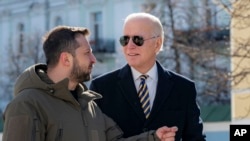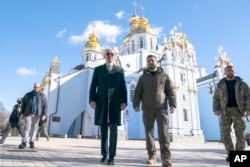On February 24, the one-year anniversary of Russia’s invasion of Ukraine, President Volodymyr Zelenskyy held a press conference underscoring his belief that his country would emerge victorious.
But an edited excerpt of Zelenskyy’s comments has widely circulated online, with commentators claiming that the Ukrainian president expects American citizens will be sent to fight in the war.
In the viral 19-second video clip, Zelenskyy can be heard saying the following through simultaneous interpretation:
“The U.S. will have to send their sons and daughters exactly the same way as we are sending our sons and daughters to war. And they will have to fight. Because it’s NATO that we’re talking about. And they will be dying, God forbid. Because it’s a horrible thing.”
Monica Crowley, host of the Monica Crowley Podcast and a former U.S. assistant secretary of the treasury, retweeted the clip with the following commentary:
“Zelensky now directly threatening us and claiming American sons and daughters will have to fight and die for Ukraine. HELL NO”
Others have offered similar assessments.
The claim that Zelenskyy said the United States would have to send its citizens to “fight and die in Ukraine” is false.
The edited clip removes the context from Zelenskyy’s statement, which concerned a hypothetical situation in which Ukraine loses the war and Russia moves against members of the North Atlantic Treaty Organization (NATO), a 30-member military alliance of which the U.S. is a member.
During the press conference, a reporter asked Zelenskyy what message he would give to those Americans who believe the United States is giving too much support to Ukraine.
Zelenskyy stressed the important role the United States was playing in defending Ukraine, before warning that if Ukraine fell, Russia aggression would not stop there.
His statement in full:
“The U.S. is never going to give up on the NATO member states. If it happens so that Ukraine, due to various opinions and weakening, depleting of assistance, loses, Russia is going to enter [the] Baltic states, NATO member states, and then the U.S. will have to send their sons and daughters exactly the same way as we are sending [our] sons and daughters to war. And they will have to fight. Because it’s NATO that we’re talking about, and they will be dying, God forbid, because it’s a horrible thing.”
Under Article 5 of the North Atlantic Treaty, which forms the legal basis for NATO, the U.S. and its allies “agree that an armed attack against one or more of them in Europe or North America shall be considered an attack against them all.”
However, that does not necessarily mean the United States (or any other NATO member) would be required to use military force to defend an ally.
“[Article 5] permits each NATO member to decide for itself what action should be taken to address an armed attack on a NATO ally. It does not require any member to respond with military force, although it permits such responses as a matter of international law. A member may decide that instead of responding with force, it will send military equipment to NATO allies or impose sanctions on the aggressor,” Katherine Yon Ebright wrote for the Brennan Center, a nonprofit law and public policy institute.
Ebright notes that the triggering of Article 5 would not skirt the constitutional restriction that only the U.S. Congress (and not the president) can declare war.
So hypothetically, yes, if Russia attacked the Baltic states — Lithuania, Latvia and Estonia — or another NATO member, the U.S. could ultimately decide to come to their defense with military force.
But the option to use military force in that event is not inevitable.
Ukraine is not a NATO member, and U.S. President Joe Biden has repeatedly pledged not to send U.S. ground troops to Ukraine.
Biden maintains that U.S. support for Ukraine, including a decision to send it 31 M1 Abrams battle tanks, is intended to help Ukraine “defend its sovereignty and its territorial integrity,” and “is not an offensive threat to Russia.”
This isn't the first time manipulated video has been disseminated to show Zelenskyy in an unfavorable light or undermine Ukraine's war effort.
In November, 2022, Polygraph.info reported how comments by Zelenskyy, in which he stressed his desire to end the war and bring peace to his country, were selectively edited to falsely portray the Ukrainian leader as threatening war.







